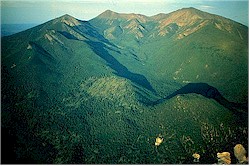
|
|||||||||||||||||||||||||||||||
|
|||||||||||||||||||||||||||||||
 |
|
Merriam's study area, the San Francisco Peaks in Arizona, rise nearly 6000 feet above the pine forests of Flagstaff. Photograph courtesy of USGS. |
The idea of mapping how plants and animals are distributed across landscapes neither began nor ended with C. Hart Merriam, but Merriam's work at the end of the 19th century was a milestone in the newly developing science of ecology. His careful field work and affiliation with the US Department of Agriculture led to wide acceptance of his "life zones" concept.
In 1889 Merriam proposed to his superiors in the federal government that he be authorized to carry out an extensive biological survey of a high mountain region "where different climates and zones of animal and plant life succeed each other from base to summit." He decided San Francisco Mountain in the Arizona Territory would be an appropriate study area "because of its southern position, isolation, great altitude, and proximity to an arid desert."
Merriam and his expedition members arrived in Flagstaff on July 26, 1889. For the next two months the scientists completed extensive field work in the high forests of the peaks, out in the Painted Desert to the east, and at the Grand Canyon. The exceptional biodiversity witnessed by Merriam and his party in this relatively small geographic area led to his first publications delineating "life zones" on a regional scale.
Merriam believed that climatic gradients, especially temperature, largely determined what type of vegetative community one may find in a given location, and that these gradients were largely a function of latitude and elevation. As one moves upward in elevation temperatures decrease and precipitation increases. His regional life zones generally followed elevational belts. At 5000 feet at the northern base of the San Francisco Peaks a grassland community might be found, but just a few thousand feet higher at 7000 feet stands a ponderosa pine forest. Each of Merriam's life zones had one or more dominant species helping delineate that particular zone, e.g., ponderosa pine being the primary indicator of his "Transition" zone. Six of the zones defined by Merriam occur in relatively close proximity on the southern Colorado Plateau, from the hot depths of the lower Grand Canyon to the windswept tundra atop the San Francisco Peaks.
Merriam used his work on San Francisco Mountain to extrapolate life zones for all of North America, emphasizing that his work in Arizona was of little interest if not applied on a larger scale. He completed a map in 1893 delineating the major life zones of the continent. Although his conclusions significantly influenced early biological thought about the American west, further study has shown that there are numerous other factors affecting the distribution of biota, including aspect (i.e., which direction the slope is facing), wildfire history and frequency, and soil type. Nevetheless, modern ecologists still consider roughly Merriam's same zones the major biomes of North America.
Merriam's Life Zones 1891 |
Modern Vegetation Zones |
Elevation
|
Annual
|
Arctic-Alpine |
Alpine Tundra |
11,500-12,700 |
35"-40" |
Hudsonian |
Spruce-Fir or Subalpine Conifer Forest |
9,500-11,500 |
30"-40" |
Canadian |
Mixed Conifer Forest |
8,000-9500 |
25"-30" |
Transition |
Ponderosa Pine Forest |
6000-8500 |
18"-26" |
Upper Sonoran |
Pinyon-Juniper Woodland, Semi-Arid Grasslands, Semi-Arid Scrub |
3500-6500 |
10"-20" |
Lower Sonoran |
Mojave, Sonoran, or Chihuahuan Desert |
100-3500 |
3"-12" |
Merriam, C. H. and Steineger, L. 1890. Results of a biological survey of the San Francisco mountain region and the desert of the Little Colorado, Arizona. North American Fauna Report 3. U.S. Department of Agriculture, Division of Ornithology and Mammalia, Washington, D.C., 136 pp.
Phillips, Arthur M. III, House, Dorothy A., and Phillips, Barbara G. 1989. Expedition to the San Francisco Peaks: C. Hart Merriam and the Life Zone Concept. Museum of Northern Arizona Plateau 60: 19-30.
Sterling, K. B. 1974. The Last of the Naturalists-The Career of C. Hart Merriam. Arno Press, New York, NY.